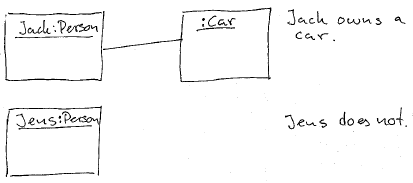package dk.itu.oop.lecture2; public class InitializeOrder { public static void main(String[] args){ AAA a = new BBB(); } } class AAA { private String a = "Hello"; private String b; private int x = 17; public AAA(String s){ b = s; } public AAA(){ b ="Goodbye"; } } class BBB extends AAA { private String c = "Go'dag"; public BBB(){ super("G'day mate"); c = "Davs"; } }
- In what order are the fields initialized and with what value, when a BBB object is created? Pay special attention to the order of initializers and constructors.
- The class CCC might have been defined as:
class CCC extends AAA { private String d = "Go'dag"; public CCC(){ super(d); } }However, this class is not legal Java. It breaks the initialization order in a subtle way. The compiler will discover this, and report the following error message: "InitializeOrder.java: cannot reference d before supertype constructor has been called" in the line containing "super(d);". In what way does the class CCC break the initialization order of Java - try to explain the problem in terms of section 9.9 in Java Precisely.
- Each car is owned by exactly one person, that is, no car is without an owner, and no car is owned by more than one person.
- Each Person can own at most one car.
- If a person owns a car, that car is owned by that person, and vice versa.

It is common for simple two-way associations that one side X must be associated to the other side Y, while Y might be associated to an X.
- Write the two classes Person and Car, such that each has a public (declaring it private will make the exercise much harder) reference field that can refer to one of the other kind, that is, class Person as a field Car car, and class Car has a field Person owner. Hint. Use the constructor of Car to make sure that a car is never created without a owner, this should take care of rule 1 & 2 above.
- Add a method void newOwner(Person p) to the car class. It should make p the new owner of this car. Make sure rule 1, 2 & 3 are respected by the method. You may assume that the person p is not the owner of an other car.
This exercise was on simple two-way associations. General two-way associations is when there is not a one-one relationship between the objects, but a person can own more than one car, or more generally, a car can be owned by several people in a joint ownership. In those situations, rule 3 still must hold. A solution to general associations is not required. Associations are an important part of the UML modelling diagrams.
In the Pen class from the lecture, change the clone method so that a cloned of a blue pen is red and a clone of a red pen is blue. Clones of green pens remain green. (Notice, this exercise can be solved without you understanding all the code in the file Drawing.java, just examine the clone method!).
Extend the class Person from exercise 2 with a clone method. It should return a clone of the Person. The clone method should be coded such that rule 1, 2 & 3 are respected.